England has some of the finest linksland in the world and is blessed with many of the best links courses on the planet - courses you have heard of and hidden gems that you simply must see, and play. England offers the greatest variety of off course activities and the finest accommodations. England is sure to delight and amaze even the most seasoned golf traveller!
Burnham & Berrow GC
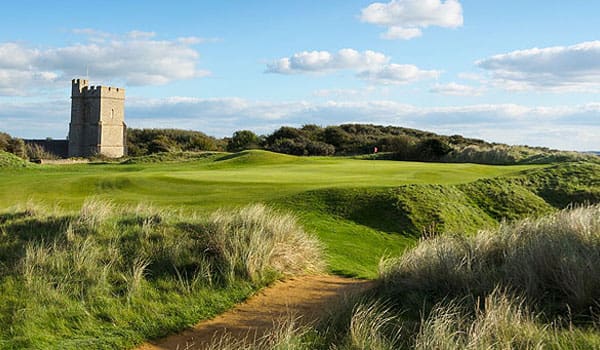
Burnham & Berrow Golf Club was founded in 1890 and soon after, they hired a youngster called J.H. Taylor. His task was to be the club’s first professional and keeper of the greens. One of the great triumvirates, Taylor went on to win the Open Championship five times.
There is a church in the middle of the course and that in itself is unusual. Over the years changes had to be made to the layout so that the faithful congregation was not in harm's way. Additionally, some of the blind drives had to be designed out.
Burhman is traditionally an out and back course filled with sandhills (giant ones too) and deep pot-bunkers. It’s a challenging layout with the tumbling fairways laid out in narrow valleys, protected by the pot-bunkers and the deep rough. The greens are small and require a precise approach shot. Then, once on the green the fun really begins; Burnhams greens are amongst the best in the British Isles.
Burnham has hosted many important amateur championships over the years and the course is regularly used for Open Championship qualification. A round at Burnham & Berrow is a must for people who have the love for links courses and is a great value for what you’re getting in these times of escalating green fees. This course comes in at #26 in England and #66 in the British Isles!
Formby GC
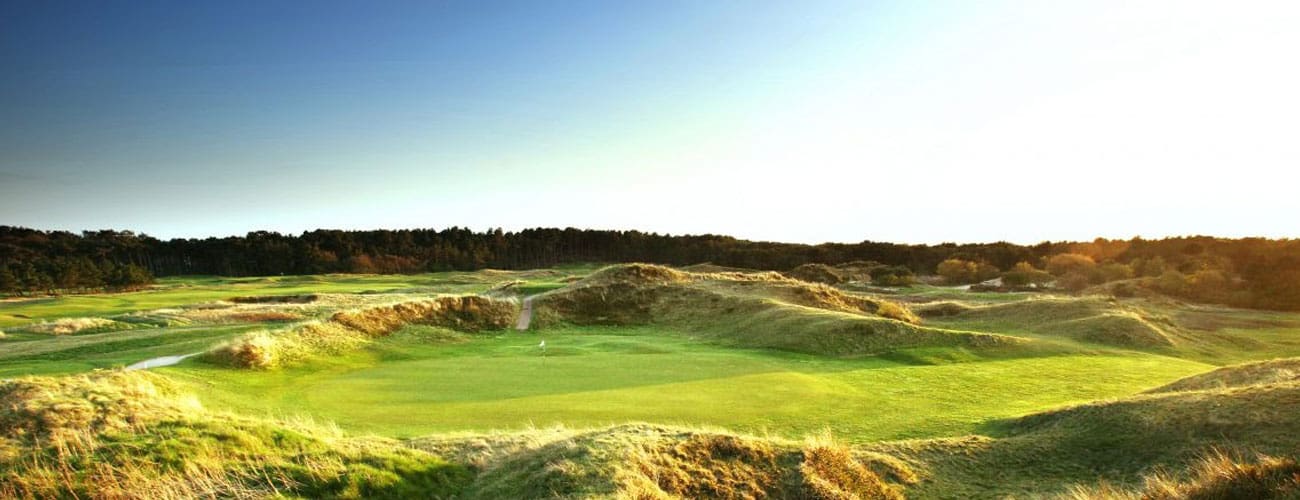
Founded in 1884, Formby GC is a wonderful club with two 18-hole layouts. Sited on 400 beautiful acres and lined on 3 sides by tall pines, and the Irish Sea to the west. Formby is one of the friendliest clubs we’ve ever visited with a lovely dormy house that makes for central accommodations in Lancashire.
Their original clubhouse was lost to fire in 1899 and the current structure was erected in 1901, and it is a throwback to a bygone era. Formy GC is a gem to be sure and while its most definitely a links, the stands of pines give it, in places, a parkland feel. Many of the tees are elevated and give the golfer a proper perspective of their holes and give the player a sense of satisfaction when one hits the fairways that lie in front of them.
We love the opening hole - a 400-yarder with the railway line on the right, and 7 bunkers with all of them in play. It’s a tough hole to start on but a well-placed drive is half the battle. Two bunkers front the left side of the green with the railway line on the right so the smart play here is middle of the green. At the 10th, you’ll amble onto a wonderful, long par-3 playing to 188-yards with a view of the sea. Three bunkers near the putting surface again make the middle of the green the proper target. This is one of the prettiest holes on the links. At the home hole, you realize you don’t want the round to end. It’s a fabulous finishing hole with the clubhouse and clock tower off the right side of the green. This 417-yard par-4 hole is dotted with 11 bunkers and again, they are all in play. Best to be safe and aim at the middle of this rather long and generous green.
Formby is simply a delight to play and the members are among the most friendly we’ve ever encountered. Stay at their dormy house and you’ll experience their hospitality first hand!
Ganton GC
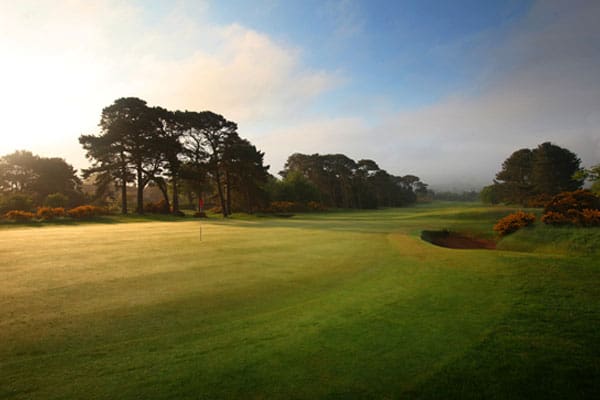
Ganton Golf Club is situated in the rural Vale of Pickering, nine miles from the sea. Even though it is an inland course it has hosted a few big competitions including the 1949 Ryder Cup, the 2000 Curtis Cup, and the 2003 Walker Cup. The Scarborough Golf Club, which was what Ganton was originally called, opened for play in 1891. It was laid out by St. Andrews’ Tom Chisholm. The great Harry Vardon became the club’s pro in 1896, the same year he won his first open title at Murifield. This immediately put Ganton on the map.
If there were to be an inland course to host the Open it would be Ganton. It has already hosted some big events and would be a great excuse to host an inland course for the tournament.
The bunkering at Ganton is very extraordinary, one of the main features at this course. With over 100 cunningly placed bunkers it is almost impossible that you do not find yourself in at least one by the end of the day. Some of these bunkers are huge, in depth and length, whilst others are small as well.
Three short par 4’s provide the opportunity of a game of risk and reward for the big hitters. A minor downside is there are only two par 3’s but the strength of the par 4’s more than compensates for this.
This club is ranked best in Yorkshire and 9th in England, and probably considered the best inland course around!
Goswick Golf Club
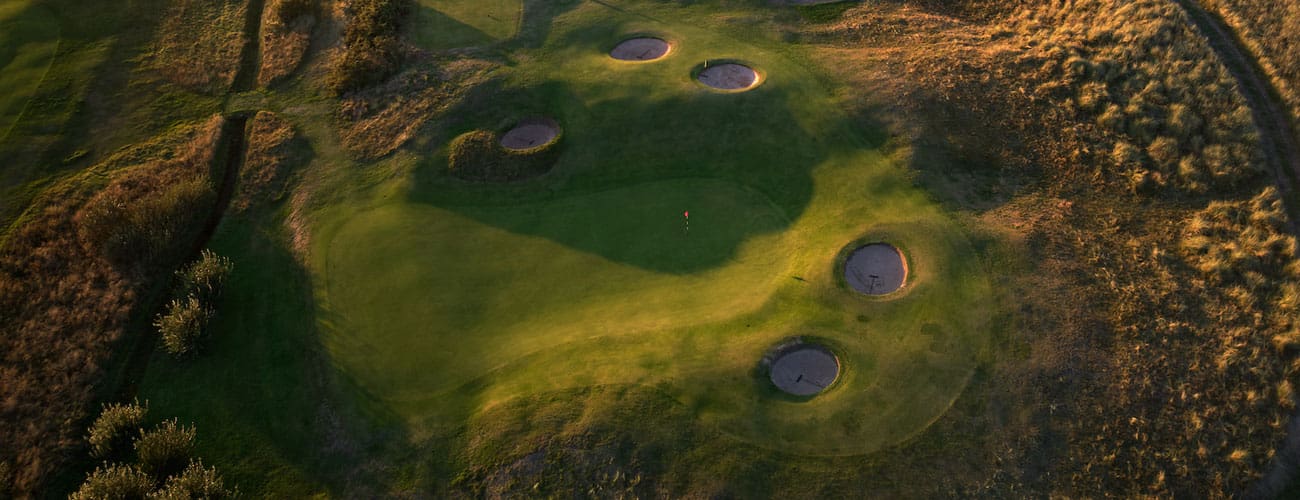
Goswick Golf Club, a Top-100 course in England, was founded in 1890 and while it’s unknown who laid out the course originally, the course was subsequently enhanced by Willie Park, Jr. in 1903, James Braid in 1930 and Frank Pennink in 1930. Goswick is a marvelous member’s club with a rich history and a bright future.
Unlike most traditional links layouts that are “out-and-back”, Goswick has two loops of 9-holes. The course has lovely views of the North Sea, Holy Island and Bamburgh Castle. Goswick has 5-sets of tees to accommodate any level of golfer but for those golfers strong enough to play the tips, they will be teeing it up at 6,800 yards and with the ever-present wind, Goswick is a challenge from any length. Goswick is blessed by beautiful dunes, heaving fairways and undulating greens – just what one expects from links golf. We feel the course’s bunkering is underrated – there are just the right number of sand hazards and most are visible vs. being hidden. The course is always in remarkable condition and is a joy to play.
Like any club that has been around 130-years, it has faced battles for its survival. During the two world wars of the 1900’s, the membership dwindled as men of fighting age were called into service. During the second world war, part of the southern section of the course was requisitioned for target practice for the rockets of the Typhoon planes. There are still remnants of the coastal defense system that was installed to thwart invasion by Axis troops.
The R&A deemed Goswick to be such a fine test of golf that the club was given the honor of hosting regional qualifying for the Open Championship. In 2018, Goswick Golf Club hosted Open Championship Regional Qualifying for the first time since 2012 and were awarded the privilege again in 2019.
Located in the northeast of England, spot on the Scottish border, Goswick is just under an hour south of N. Berwick and just over an hour drive from Edinburgh. It’s a beautifully scenic and easy drive, and to a club that is certainly worth the effort. We love English golf and Goswick is a links we suggest adding to every itinerary that will be playing in the Edinburgh-area.
Hillside GC

Hillside is an underappreciated gem, separated only by a footpath and hiding in the shadows of it’s neighbor Royal Birkdale. The railway line separates Hillside from Southport and Ainsdale, another quality but relatively unknown links.
Today’s layout is very different from the original Hillside that was founded in 1911. The Club bought some new land in the 1960’s and Fred W. Hawtree extensively remodelled the course, making major changes to the back nine. The front nine has always been highly regarded and plays over relatively flat ground, but it’s the back nine that is really special because the holes ripple and undulate through the giant dunes.
There are many hole that will test you and many that will excite you, but #11 is at the top. Being a reachable par 5 just over 500 yards, a decent drive down the middle of the fairway will tempt any golfer for going for the raised green in two, but beware of the bunker lurking to the right!
Hillside has hosted both ametuer and professional big events, including the 1982 PGA Championship where Tony Lackin beat Bernhard Langer on the first play-off hole. Hillside also hosted the British Masters in 2019.
This course ranks at #23 in England.
Littlestone GC
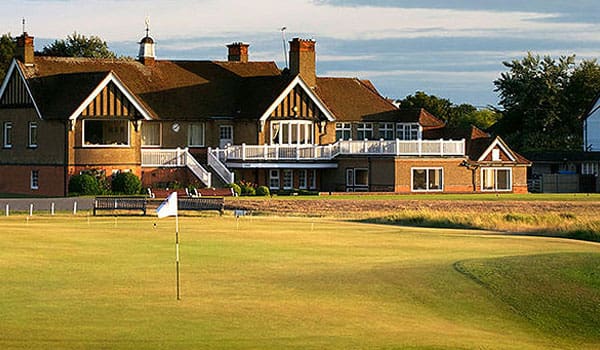
Founded in 1888, Littlestone Golf Club is a classic remote links course, located on the fringe of the Romney Marshes, with the English Channel as the backdrop. The British Ladies Open was held at Littlestone six years after the course opened. This course was originally designed by Laidlaw Purves. Over the years many modifications were made including the bunkers after world war 2.
Littlestone is a hidden gem, overshadowed by the other famous courses that it is surrounded by, including Rye, Royal St George’s and Royal Cinque Ports. The course plays across fairly flat links land, although it does have its own range of sand dunes. New Romney is one the the driest places in the British Isles so you rarely will need the wet suit while playing down there. The dry flat ground makes for some interesting tight lies but rarely will you be faced with awkward stances. The greens are true and fast making it difficult to hold the ball.
There are no tricks here at Littlestone, you can see every hole clearly from the tee box. You need to be on top of your game to keep your score together; the last three holes are among the toughest around. At Littlestone they like to get you around in about 3 hours. This is a delightfully good golf course and if you’re feeling brave enough they allow visitors to play from the medal tees.
Perranporth GC

Perranporth is located in Poldark country, on North Cornwall’s dramatic Atlantic coastline. This course is a natural links that is set on high ground to give amazing views of the Perran Bay. In 1927 the great James Braid designed this course and has had no revisions since then.
This course is filled with blind shots including 7 from the tee boxes and a few blind approach shots. This can cause an interesting and “fun” layout, especially when the ground is hard and fast. The course measures at 6,252 yards from the back tees and is a par 72. Greens are firm, undulating and set up on a raised plateau calling for very precise approach shots. Perranporth is rated highly among the other courses close to it including St Enodoc, Trevose, and West Cornwall. Currently ranked by Top100courses.com at #69 in England. This course is a very natural and sought out course that comes highly recommended.
Princes GC

Prince’s has three championship nines on a lovely property that adjoins the course at Royal St. Georges. Founded in 1904 as an 18-hole layout that welcomed juniors, ladies and families, the course was requisitioned twice by the British government for wartime maneuvers. Between the two great wars, Prince’s played host to the 1932 Open Championship won by American Gene Sarazen. As WWII began, the course was used as a training site through the war but fortunately it was decommissioned in 1949. In 1950, the layout was rebuilt and expanded to 27-holes that exist to this day. The nines are known as Shore, Dunes and Himalayas.
The “championship” layout is made up of the Shore and the Dunes nines with Himalayas being a nice, shorter nine. The Shore and the Dunes track is a wonderful layout and from the back tees, it’s a real test of golf. The turf here is superb and the greens are all maintained to a world class standard. We love all three of the nines and are happy to play any combination of the three.
There’s a wonderful story of Perry Lucas, a Prince’s member and fine amateur player who volunteered for military service in the 1940s. He became a flying ace and piloted Spitfires against the enemy in Europe. In July 1943, his plane was damaged by enemy fire and was losing altitude as the cockpit filled with smoke. Flying over the English Channel headed for RAF Marston and realizing he would need to set the plane down before reaching Marston, he looked for familiar landmarks. Spotting the old Prince’s clubhouse, he aimed his Spitfire for the fairways of the very club his father founded. Flying low above the fairways of the 2nd, 4th, 8th, 9th and 12th fairways he landed the plane just beyond the boundary fence near what is now the 2nd green on Himalayas. Today, a plaque and replica propeller stand where his Spitfire came to rest. The brave Mr. Lucas went on to play for GB&I in the 1947 and 1949 Walker Cup teams.
Prince’s also has a lodge that offers exceptional dormy-like on course accommodations with views out onto the course.
Royal Birkdale GC

Royal Birkdale is one of the crown jewels of links golf and certainly part of the royal ‘family’ of courses in England. Located in Lancashire on England's north west coast, Birkdale is on a fantastic piece of property. This links has hosted many memorable Open Championships including the 2017 thriller that saw Jordan Speith edge Matt Kuchar. Many other great championships have been hosted here including the Women’s Open, the Senior Open, the Walker & Curtis Cups and of course, the Ryder Cup. Birkdale is where Jack Nicklaus famously conceded a short but missable putt on the final hole to Tony Jacklin in the 1969 Ryder Cup which is known as the “Concession”. That gesture allowed GB&I to tie the US 16-16 thereby allowing the US to retain the Cup for another 2 years.
With its iconic, white modern clubhouse as a backdrop, Birkdale starts off with a beast of a par 4 playing at 450 yards to a green fronted by 3 cavernous bunkers. We love the short par 4 fourth hole that plays to just 343 yards. The green slopes left to right and is nearly encircled by the 6 pot bunkers that surround the green. We cannot think of a more fun par 4 to play anywhere. On the most recent time we played Birkdale, as we arrived at the 18th, our caddies asked if we’d like to play from the Championship tees. They led us up a small hill to a tiny pad hidden from view by tall marram grass. Playing into a 2-club wind, our 3 intrepid golfers teed off nicely but not spectacularly. Our group consisted of a 5-handicapper, a 10-handicapper and a player playing off 18 strokes. We each hit very solid shots that fought the wind and rolled to a stop exactly to where you would guess our handicaps would allow. The player playing off 18 chipped in for birdie, the 10-handicapper made a 30 foot putt for birdie and 5-handicapper made a mid-length putt for birdie. The fact that we all all birdied 18 in a 2 club wind from the Championship tees literally made the trip for us and we still talk about it to this day. Birkdale is a course you don’t want to miss!
The Lancashire coast has many great links on it’s shores and we’d be happy to arrange times at Royal Lytham, Hillside, Southport & Ainsdale or West Lancs when you’re in the Birkdale area.
Royal Cinque Ports

More commonly known as Deal for the name of its town, Royal Cinque Ports is a classic nine out and nine backlinks routing. Founded in 1892, the club at Deal hosted the Open Championship in 1909 and 1920.
Deal plays to a par of 71 over its 6,500 yards from the member’s tees but the course is a tale of two very different nines. The front plays almost exclusively downwind and the homestretch plays dead into the wind. I remember shooting 35 downwind and 45 into the wind coming back the first time we played there.
Our favorite hole is the short 6th hole which plays as a par 4 at just 356 yards. The tee is set near the sea wall and the hole parallels this wall its entire length. Playing downwind, the distance would suggest that it's drivable for big hitters but the green complex says otherwise. Best to play it more conventionally as a two-shotter with a modest drive and a wedge into the green. The fairway is rumpled and tight requiring a precise drive as the fairway bends to the right. The second shot plays to the smallest green on the course and it’s elevated and set hard against the sea wall. The green spill-off on all four sides and balls are often repelled back down and below the green. It’s a quirky hole by N. American standards but it is truly pure links fun.
Royal Cinque Ports has a rich and colorful history. Just consider the following anecdotes. The shore at Deal faces Europe and with London lying just 80 miles west, it’s no surprise that during WWII, the course was fortified as a defensive measure to thwart the invasion. Anti-tank barricades and machine gun turrets were installed at the outset of the war are still on-site, visible to golfers, and worth taking a look at.
Deal is famous for a stance taken by American professional golfer Walter Hagen at the 1920 Open Championship. At the time pros were not allowed to enter the clubhouse as they were seen to be a lower class than the members of most private clubs. Pros were expected to change in the pro shop. Hagen arrived each day in his chauffeur-driven ‘Austro Daimler’ and parked his car beside the club’s flagpole. For the duration of the championship, Mr. Hagen dressed in his hotel but changed his shoes and took his meals in his large luxury car rather than be treated as a second-class citizen.
The club has an old traditional clubhouse with a friendly membership and very good food. Deal is a course in Kent that is not to be missed.
Royal Liverpool GC

Founded and built in 1869, the Royal Liverpool Golf Course or Hoylake, as it’s referred to locally, is a true championship links that has proudly hosted 12 Open Championships and will play host to the Open in 2022. Laid out originally by George Morris and Robert Chambers as a 9-hole track, it was extended to 18-holes in 1871 and received its ‘Royal’ designation that same year.
Hoylake reminds us of another classic links, Muirfield, as both rest on relatively flat ground which is rare for true links courses. The middle of the course does offer more undulating ground with traditional sidehill stances and unexpected bounces. The bunkering here is superb and some would say artistically placed. The greens here are second to none and maintained to the highest standard. It reminds us of the contrast between just how wild and untamed the rough is in links golf compared to how the greens are so impeccably manicured, almost faultless.
Four holes, 9-12, play through the dunes and along the shore, and you’d be hard pressed to find a better string of 4 holes anywhere. Perhaps our favorite is the par-4 tenth as it provides a wonderful example of artistic bunkering mentioned earlier. The hole plays as a 392 yard dogleg left with a trio of nearly identical fairway bunkers down the right side that catch balls that are not drawn back into short grass. From there, the second shot requires a deft approach to a bunkerless green but protected by steep runoff areas back, left and right. No greenside bunkers but 3 devious fairway bunkers make this unusually fun and difficult golf hole.
The old iconic clubhouse was built in 1895 and is a lovely throwback to the heyday of yesteryear. Wonderful food and drink can be enjoyed in the clubhouse with views through the large windows that overlook the course out to the sea.
Royal Lytham GC

Royal Lytham was founded in 1886 and has hosted the Open Championship eleven times. It’s one of links golf most iconic courses and it's one of the most often played courses in the UK played by our guests. Lytham is a tough track and only Carnoustie is regarded as tougher on the Open rota.
Located in Lancashire, it is an area rich in history and tradition. Royal Birkdale and Royal Liverpool are nearby along with many other fine links like Hillside GC, West Lancs, Tenby, Southport & Ainsdale and Formby. A golfing traveller could make an exceptional trip without venturing more than 30 miles from a central home base in Lancashire.
Lytham is unique in that it is the only course in the Open Championship rota to start with a par 3. And what a par 3 it is - 206 yards to a green well protected by several pot bunkers. It requires your full attention right from the start and it doesn’t let up there. The course has 18 fantastic holes guarded by 174 bunkers that require precise shotmaking. Two things stand out about Lytham for most golfers. First, the greens are among the best in the world - large, fast and undulating but fair. And second, the caliber of the bunkers. These are riveted, sod faced bunkers with several being left with craggy grass on the tops just as they looked in the 1800s.
Our favorite hole here is the 17th, a par 4 that plays to 467 yards and is famous for Bobby Jones hole out for eagle in the 1926 Open Championship. A plaque lies on the spot from where he struck his second shot from a difficult lie. Lytham is a wonderful test of golf and one not to be missed when in north west England.
Accommodations in the area are excellent and many of our guests love staying at the Dormy House at Royal Lytham & St. Annes.
Royal North Devon (England)
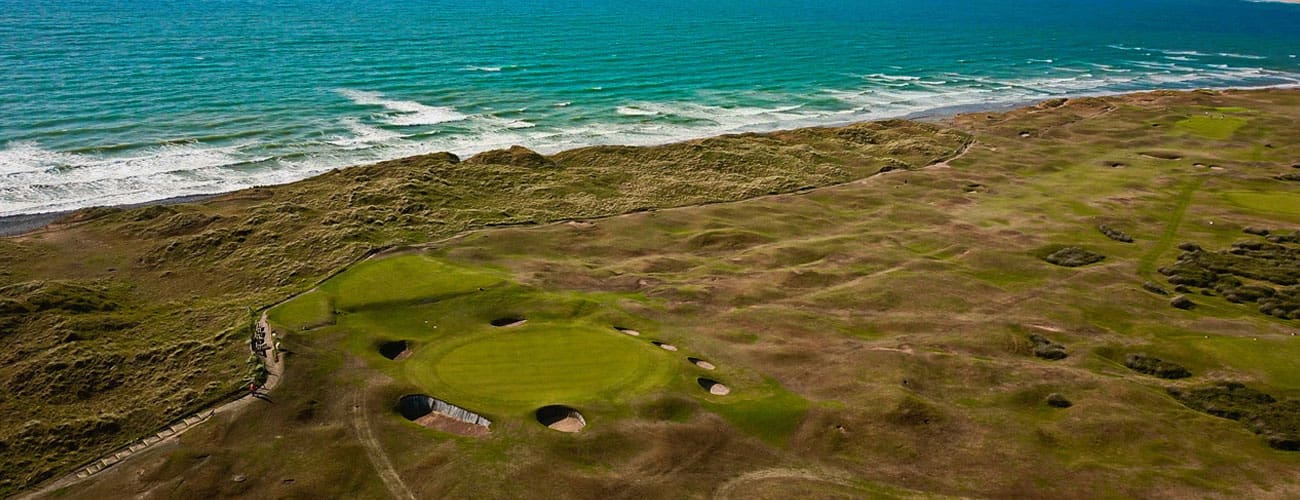
Royal North Devon, mainly known as “Westward Ho!” is a nostalgic and monumental links course that fits firmly in the “must play” category. In 1864 Westward Ho! opened for play and it remains the oldest course in England still playing along its original fairways. It's the oldest golf course outside of Scotland and home to the second oldest ladies golf club in the world, founded in 1868. The oldest ladies club was founded at St. Andrew's one year earlier.
When you look out to the course from the clubhouse you might struggle to define the holes a little bit. They simply blend into the surroundings. There are no trees or hedges just plenty of reeds and rushes waiting to catch the wayward shot. Make sure you buy a yardage book if you do not know the layout; otherwise you may find yourself teeing off towards the wrong hole.
This course was originally laid out by Old Tom Morris and revised in 1908 by Herbert Fowler. Nothing much has changed since then. There are still sheep and horses that casually graze the course. It is a known rule at Westward Ho! that if your ball ends up in a hoof mark you are able to drop with no penalty.
This course is ranked 2nd in Devon and 60th in England.
Royal St. Georges

Royal St. Georges, or Sandwich as it is known locally, is a fabulous club in a beautiful part of the world. Along the same stretch of coast lies 2 other Open Championship venues from the past - Prince’s and Royal Cinque Ports. These courses line up like links on a chain, literally separated by simple fencing with all sharing the same magnificent land features.
Sandwich represents the purest form of links golf. The course is very open with barely a tree in sight, fully exposed to the elements that thrust the ‘rub of the green’ upon us. The earth here is very uneven and every type of lie is presented to challenge one’s shotmaking abilities. The fairways roll and heave like a rough sea with humps and bumps that direct ill-placed drives into hidden bunkers. There are blind and semi-blind shots into greens that transport you back in time to when this type of course design was common. The greens are generously proportioned so as to not penalize shots coming in from these unseen positions. The greens are meticulously maintained and roll fast, and true. Because of their enormity, 3-putting can become habit forming here.
We keep a log and rating system for every links course we play and our #1 course is Royal St. Georges. It’s not just the golf that makes this club so grand. Sandwich has a magnificent and historical clubhouse with a jacket and tie lunch that is not to be missed. The members are friendly and the facilities are all first-rate. It’s no wonder that Royal St. Georges has hosted the Open Championship 15 times between 1894 and 2021.
The town of Sandwich is a lovely village with very nice restaurants, comfortable accommodations, and wonderful pubs. It’s a perfect spot to stay and enjoy the golfing life that Kent has to offer.
Rye GC (Old)
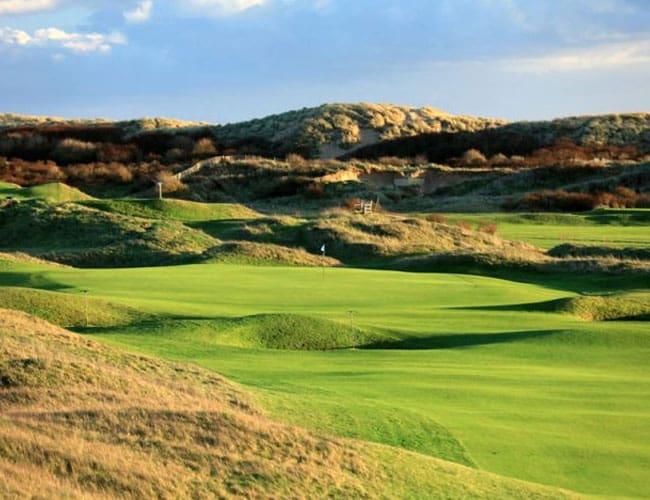
Rye is one of the most private courses in the British Isles. It is easier to get a game on the Old Course at St. Andrews. This is where “knowing the right people” can come in handy! With the right timing and luck we may be able to get you on this magnificent course.
Rye was founded in 1894. Harry Colt, at 25 years old, laid this course out. It was his debut course and one that was most impressive for a first timer. Today’s layout bears the hallmark of Tom Simpson and Sir Guy Campbell, though the Second World War almost obliterated the links and a flying bomb almost destroyed the clubhouse. But, thanks to the faithful view, Rye rose up like a phoenix.
A couple big factors at this course are the wind and the stances. The wind is no more than any other course but with the direction the course is laid out the wind is always blowing across the links making it rather difficult. With the stances, well, let's just say you’ll never have a flat lie. Shot after shot will be tested with a different lie and only the best golfers will be able to maneuver around on this course.
With only a par of 68 and a course that measures to 6,300 yards this has got to be one of the toughest courses in Britain. Only one par five is available and it comes right off the bat! You’ll have to try and take advantage of the 3 short par 4’s, because the other nine are more than 400 yards from the tee. This course is a true test of the average golfer which makes it even more enticing! If you happen to find yourself a tee time here at Rye then consider yourself lucky and honored! Then take advantage of the #24 course in England.
Saunton GC (East)

If there was a need for another seaside Open Championship venue, surely the East course at Saunton Golf Club is a worthy candidate. Saunton has never hosted the Open but it has hosted other important events such as the Boys Ameteur Championship where Sergio Garcia won in 1997.
Saunton is located on the beautiful unspoilt North Devon coast. On the edge of Bideford Bay and the estuary of the River Taw, lies the fantastic course.
The East course, laid out in 1897, runs through a small part of this amazing expanse of sand dunes. Herbert Fowler added a bit of redesign magic in 1919 taking full advantage of the natural terrain, routing the holes with precision and skill. Fowler is responsible for the masterpiece at Walton Heath and Saunton was perhaps his finest seaside creation.
Today’s East course is very different from what it used to be; undeniably a very tough course. With eight par 4’s measuring more than 400 yards and only 2 par 5’s low scoring is very difficult. Although it may be a bit tough it is surely one of the best seaside links courses in England.
Seaton Carew Golf Club
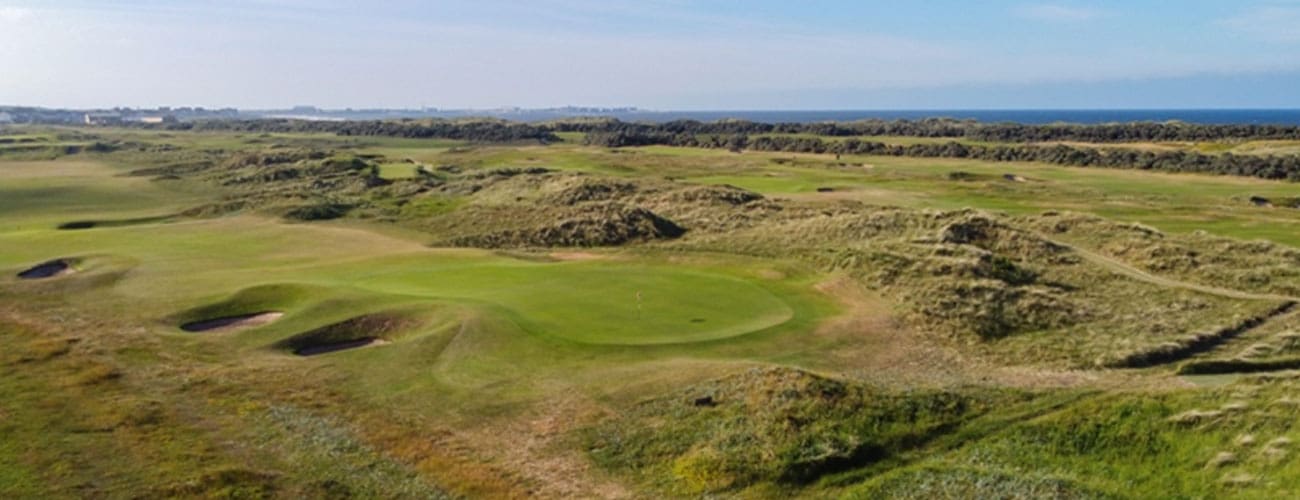
Seaton Carew, as a club, was formed in 1874 making it the 10th oldest club in England. Originally known as the Durham & Yorkshire Golf Club, the club changed its name to Seaton Carew in 1887, added a clubhouse and extended the course from 14-holes to 18 in 1891. In 1974, the club agreed to allow an oil pipeline to run under part of the course and with the financial proceeds, added 4-holes bringing their total to 22-holes. With this number of holes, the club can play 4-variations of 18, making it a very unique golfing experience.
Located in the northeast of England, south of Newcastle, near the town of Hartlepool – Seaton Carew is a wonderful members club. Visitors receive a genuinely warm welcome from the staff, the pro and literally every member of the club. One of the reasons we are comfortable recommending Seaton Carew is this rare welcome. When playing more famous courses, one receives a less warm, more ‘corporate’ welcome. What one gets at Seaton Carew is a welcome that is authentic and heart-felt.
The course is a true test of links golf with its share of hazards - beautifully strategic bunkers, Donald Ross-esque raised green complexes, the ever-present wind strengthened by the looming North Sea and a wall of buckthorn bushes that form an impenetrable spiky wall along 4-holes – this is links golf of the highest order. As such, the club has hosted more than its share of top-shelf competitions including the British Boys Amateur, the British Girls Amateur, the Barbazon Trophy (English Amateur Stroke Play Championship), the Jaques Leglise Trophy (GB&I Boys vs European Boys) and the North of England Open Amateur Championships .
In 1925, the original 18-hole layout was improved and strengthened by Dr. Alister McKenzie who not long after completing Seaton Carew, collaborated with Bobby Jones in designing a golfing masterpiece in Augusta National. With the 150th anniversary approaching in 2024, the club appointed Royal St. George’s deputy greenkeeper, Tom Coulson, to recreates aspects of the original McKenzie-designed course to be reminiscent of the course’s original, magical McKenzie layout of a hundred years ago.
We love English golf and there are many ‘diamonds-in-the-rough’ in that part of the country. Seaton Carew is one we suggest you add to every English itinerary that takes you up north.
Silloth on Solway GC
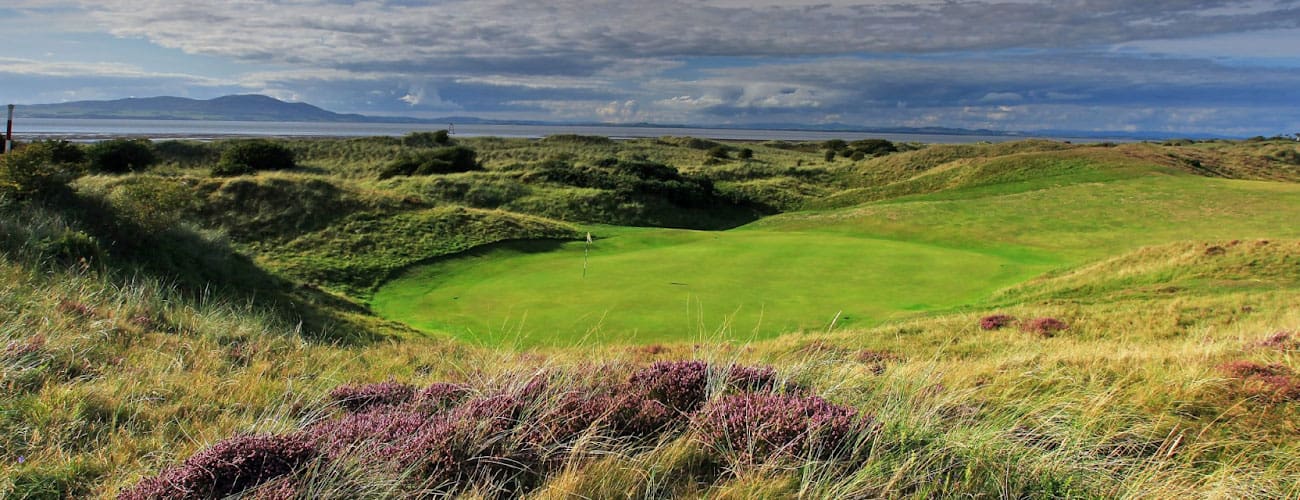
Silloth on Solway is truly a diamond in the rough. Set in a remote part of northwest England, this links is ranked 20th in England and 47th in the British Isles. Silloth is a wonderful example of true links golf and when the purple heather and yellow whin is in bloom, there isn’t a more beautiful course to be found.
Silloth was founded in 1892 and designed by N. Berwick professional David Grant and later refined by Willie Park, Jr. Silloth is unapologetically a throwback in time to when links layouts had blind tee shots and approaches, and when greens were small and hidden from view. By today’s standards, we would call it quirky but it is a ton of fun! Make no mistake, Silloth is in a remote part of northern England and quite close to the Scottish border but it is well worth the effort once you arrive.
Silloth grabs your attention right from the start. The opening hole is a wonderful par-4 that plays to 380-yards from the member tees and an infinity fairway. The approach is a blind one over a plateau to a hidden, sunken, upside-down, saucer-shaped green. The sixth hole is a lovely par-3 that plays to 180-yards from the member tees over the old rail line to a green guarded on the left by a pot bunker and on the right by a bunker and a hillock.
We love the back-to-back par-5s on the second nine. Most consider the 13th to be Silloth’s signature hole. This par-5 plays to just 468-yards and while it is reachable on a good day, the approach is treacherous with a plateaued green that runs off to the left into heather and it drops severely on the right into heather, and gorse. At the 14th, another reachable par-5 that plays the approach to a blind green guarded by bunkers left and right. Two lovely par-5s that given the winds can be an easy 4 or a hard 7!
Silloth on Solway is a lovely test of golf in a remote part of England. Silloth is actually closer to Edinburgh than to Manchester which makes combining it on a trip with Scottish courses sensible. We combined it with a play at Southerness in Scotland which was a very easy drive. Silloth on Solway is a joy to play and worth every effort to get there.
Southport & Ainsdale GC
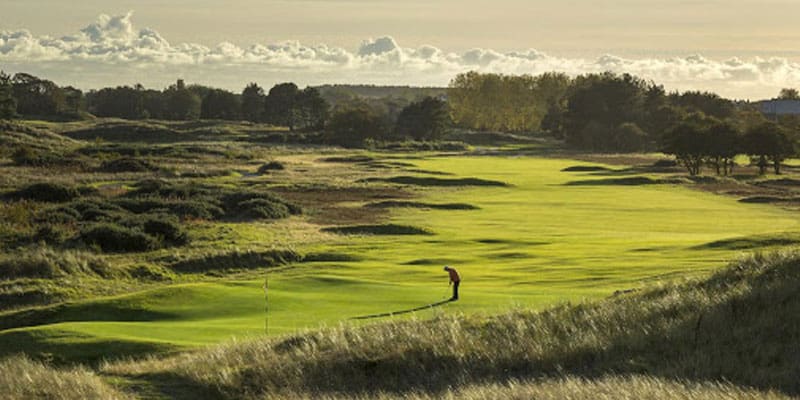
Southport & Ainsdale or S&A, as it is more commonly known, is perhaps the most underrated links we’ve ever played. Likely because its famous neighbors have hosted so many Open Championships at Royal Lytham & St. Anne’s and Royal Birkdale. Nonetheless, S&A is a stunner of a course.
The host of two Ryder Cups in the 1930’s, S&A has an outstanding pedigree. Only the Belfry has hosted more home Ryder Cups than S&A. Founded in 1907, this historic course has an old-time feel to it with several blind tee shots and the occasional approach that is obscured by the heaving fairways. The green complexes are raised in many instances creating difficult pitch shots if one misses the greens.
The course is roughly set up as two loops with the inner loop being made up of holes two through six with the remainder of the holes encircling these inner five holes. Many of the holes play through the valleys between the dunes and the bunkering here is simply superb. The course, at times, has a heathland feel with stands of pine reminiscent of Formby, but make no mistake, this is true links golf.
The par-5 second hole is a fan favorite that has heather running parallel to both sides of the fairway and several strategically placed bunkers. This is a 554-yard three shotter that is stroke index 7 as it plays through some rather mild dunes. At the par-3 eighth hole, you’ll encounter 147 yards to a bunkerless, tabletop-like green. Only the best shots will remain on the putting surface and into a strong wind, this is not a certainty.
We simply love S&A because it is pure links fun and given its lack of notoriety, it’s a course that surprises you with just how good it really is to play.
St. Enodoc GC (Church)
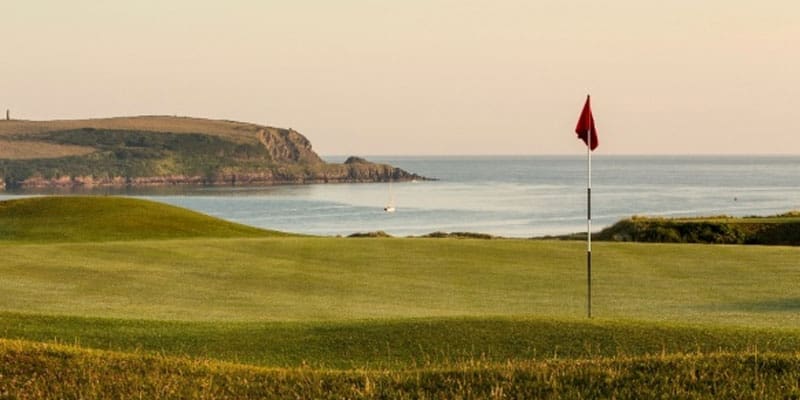
St Enodoc Golf Club is located at the royal sailing town of the Rock. This links course overlooks the Camel Estuary and the harbour at Padstow. The Church course got its name from the 13th century place of worship that stands to the right of the 10th green. In the middle of the 19th century, a fierce storm completely covered the church in sand and it was eventually extricated in 1863.
Although St Enodoc was founded in 1891, it didn’t really become notable until James Braid refashioned the course in 1907. St Enodoc is definitely an exotic and rather hilly course, set among towering dunes clad with tufts of wild sea grasses. This course's terrain is entirely natural and each hole gives a new experience.
This course is covered with some unusual and very difficult holes. Let’s take #6, you lead off with a blind drive followed by a blind mid iron second shot that must carry a huge sand dune that has been given the name “Himalayas”. This 75 foot high sand dune stands tall around 100 yards out from the green. The 10th is also very unusual, with a tee shot that is elevated you must precisely drop your drive over a valley onto a pencil thin rippling fairway.
With this course being #1 in Cornwall and #10 in all of England it’s a must to play and visit this magnificent links course.
Trevose Golf and Country Club
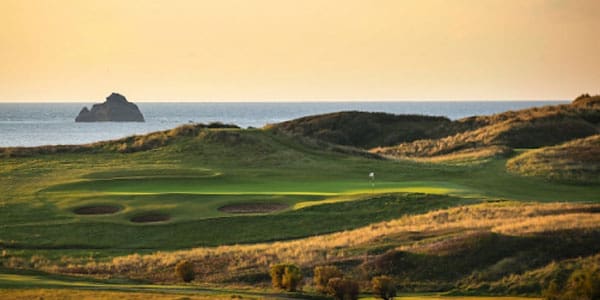
Trevose Golf and Country Club is located a little south of Cornwall, along the Atlantic Coastline at Constantine Bay. With dramatic views across the golden sandy shore of Boobys Bay to the rugged coastline of Tevose Head, it’s sheer drama.
Founded in 1926, the great Harry Colt designed the championship course at Trevose, and Sir Guy Campbell made minor revisions just before the Second World War. It’s an exhilarating windswept links where little else other than dune grasses survive in the bleakness.
Trevose is a stern test of golf, especially when the wind is swirling. This par 72 stretches to 7,172 yards from the back tees. The crumpled fairways are generous in width and the rough is kept short to keep up the speed of play and prevent too many lost balls.
Some regard Trevose as a holiday course, but the course is technically challenging and will test the very best golfers. The course record of 66 stands as a testament to its level of difficulty. Birdie opportunities are there for the taking on the three short par fives, but make the most of it because many of the par fours are aggressive and supremely challenging. Five of them stretch out over 400 yards. Trevose comes in at #66 for England and a delight to play!
Wallasey Golf Club

The club known as Wallasey was founded in 1891 by members of nearby Royal Liverpool and the course was originally laid out by Old Tom Morris. Located on the Wirral Peninsula just across the River Mersey, Wallasey is a throwback to times of old with the links crawling through the sprawling dunes. The land in this part of England is ideally suited to links golf and there is no shortage of wonderful samples nearby of the ancient game including Hoylake, Birkdale, Lytham, Formby, Hillside, S&A and West Lancs to name a few.
The course measures just 6,500-yards from the back tees but don’t allow the relative short yardage to lead you to believe Wallasey isn’t a stern test. With an ever-present wind across a layout that isn’t out and back but rather like Muirfield, where the holes go in every direction - the wind confusingly hits the golfer from every angle making Wallasey a true links examination. The course is renowned for its marvelous greens and there isn’t a weak hole among the eighteen. Perhaps our favorite is the bunkerless par-4 tenth. A dogleg right from an elevated tee with no green in sight, to a fairway guarded on the right to an enormous sand dune. The green is sited on a perch with run offs on all four sides. Scoring well here is dependent on one’s approach staying on the green. We love this hole.
Bobby Jones qualified for the 1930 Open Championship by playing his qualifying rounds at Wallasey. Jones won the Open at Hoylake that year and that same year, he also triumphed in the US Open, the US Amateur and the British Amateur. After all that success, Jones quietly retired from competitive golf. He was made an honorary life member in 1931 and remained in contact with the club throughout his life.
Wallasey is an enchanting course steeped in history and one that should be on every golfer’s trip to northwest England, England’s golf coast.
West Lancashire GC
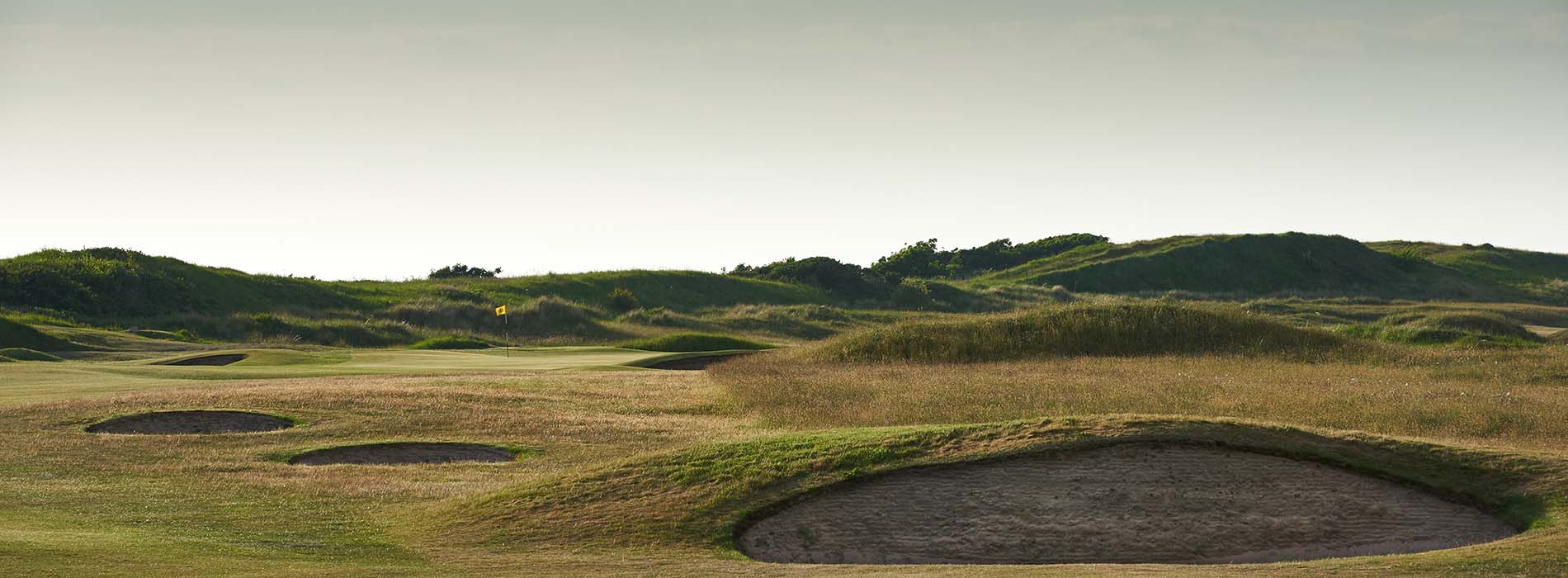
West Lancashire Golf Club is the oldest surviving golf club in Lancashire. In 1901, Harold Hinton, one of the finest amateur golfers of all time, was the secretary of West Lancashire Golf Club. That same year he won the British Amateur Championship at St. Andrews, beating J Low by one hole. Hilton was also the British Open Champion in 1892 and 1897, a feat only surpassed by 3-time winner Bobby Jones.
The club was founded in 1873. No one actually knows who originally designed the course but we suspect that mother nature did most of the work. We do know that Ken Cotton and Fred Hawtree made significant revisions to the layout in the early 1960’s.
The royal neighbors keep West Lancs out of the limelight but it is a truly classical links course, located on a charming stretch of prime links land. On a clear day, to the north, Blackpool Tower can be seen in the distance. To the southwest, there are panoramic views across the Crosby Channel to the Birkenhead peninsula and Liverpool Bay beyond. Coming in at 41st in England this course will pair nicely with the royal courses next door.
